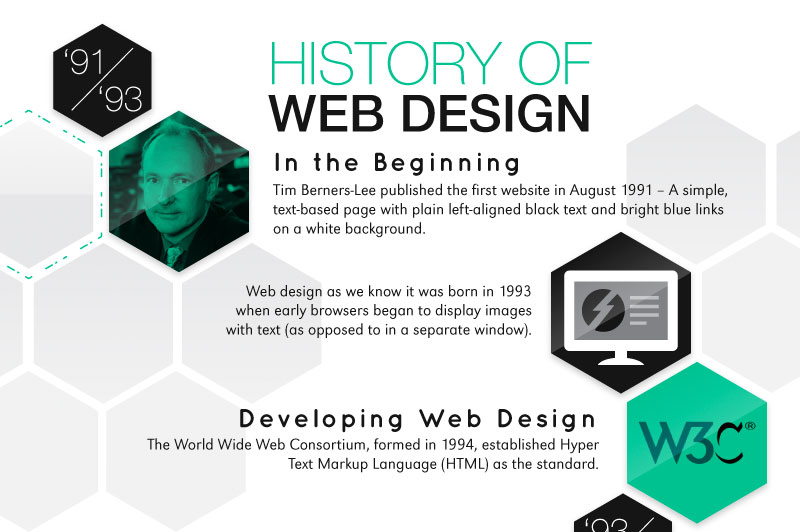Interested In Finding Out How Web Site Style Has Advanced? Take A Trip With The Transformation
Interested In Finding Out How Web Site Style Has Advanced? Take A Trip With The Transformation
Blog Article
Personnel Author-Thorsen Clarke
In the past, websites were easy and focused on details. Navigating was straight, and style was for desktop computers. Now, user experience is key. Information overviews designs for very easy navigation. Responsive designs suit various tools. Today, dark mode reduces pressure, and minimal food selections improve navigating. Interactive attributes involve individuals, and strong visuals stand out. AI assimilation boosts engagement. See how style has actually advanced to enhance your on-line journey.
Very Early Days of Website Design
In the very early days of web design, simpleness preponderated. Websites were basic, with limited colors, typefaces, and layouts. The emphasis was on offering information as opposed to showy visuals. Users accessed the net through slow dial-up links, so speed and capability were key.
Navigating food selections were straightforward, typically located on top or side of the page. Websites were made for desktop, as mobile surfing had not been yet widespread. Content was king, and designers focused on simple readability over complicated style elements.
HTML was the main coding language used, and designers needed to work within its restrictions. Computer animations and interactive functions were marginal contrasted to today's standards. Web sites were static, with little vibrant content or tailored user experiences.
Rise of User-Focused Style
With the development of website layout, a shift towards user-focused style principles has actually come to be progressively famous. https://www.mytotalretail.com/article/the-importance-of-having-an-effective-digital-marketing-strategy/ , creating websites that prioritize user experience is important for engaging site visitors and attaining organization objectives. User-focused layout entails recognizing the requirements, choices, and behaviors of your target audience to customize the site's format, web content, and features appropriately.
Designers currently conduct extensive study, such as customer surveys and use screening, to collect insights and comments straight from individuals. This data-driven strategy helps in creating intuitive navigating, clear calls-to-action, and aesthetically attractive user interfaces that reverberate with visitors. By putting the customer at the center of the design procedure, internet sites can supply a more personalized and pleasurable experience.
Receptive design has actually additionally become an essential facet of user-focused design, making certain that internet sites are optimized for numerous tools and display sizes. This adaptability enhances accessibility and usability, dealing with the diverse ways users connect with internet sites today. In essence, the increase of user-focused design indicates a change in the direction of creating electronic experiences that prioritize the requirements and assumptions of the end individual.
Modern Trends in Web Design
Explore the latest fads forming web design today. One noticeable pattern is dark mode style, providing a streamlined and contemporary appearance while lowering eye stress in low-light settings. Another crucial fad is minimal navigating, streamlining food selections and improving customer experience by focusing on essential elements. Incorporating micro-interactions, such as animated switches or scrolling results, can produce a much more engaging and interactive website. Responsive style continues to be vital, ensuring seamless user experiences throughout various gadgets. Furthermore, using vibrant typography and asymmetrical layouts can include aesthetic passion and draw attention to particular web content.
Integrating AI modern technology, like chatbots for customer support or individualized referrals, enhances user involvement and improves procedures. Accessibility has additionally end up being a significant pattern, with developers prioritizing inclusive layout practices to cater to diverse individual requirements. Welcoming sustainability by optimizing website performance for speed and efficiency is one more arising trend in website design. Working together with user responses and data analytics to repeat and enhance style constantly is essential for staying relevant in the ever-evolving digital landscape. By embracing these modern-day patterns, you can produce an aesthetically attractive, user-friendly website that resonates with your audience.
Conclusion
As you review the advancement of site layout from the early days to currently, you can see just how user-focused design has actually become the driving force behind contemporary patterns.
Embrace the trip of adjustment and adaptation in web design, always maintaining the customer experience at the center.
Tippingpointdigital
Keep present with the latest patterns and technologies, and never ever quit advancing your technique to produce aesthetically stunning and user-friendly internet sites.
Progress, adapt, and produce - the future of web design remains in your hands.
